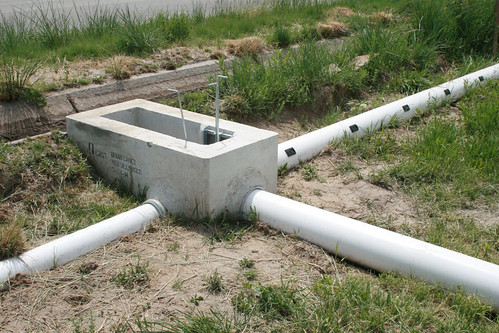
Ken Sills has had difficulties getting water to his hayfields for years, impacting his ability to use his Grand Junction, Colorado land efficiently.
“I just couldn’t get irrigation to the back of my place,” Sills said. “I tried a ditch and siphon tubes, but there were areas that were not getting water, so that’s when I went to the NRCS.”
In his quest for help, he found USDA’s Natural Resources Conservation Service (NRCS), and staff there helped him install an efficient irrigation system. The system included an above-ground conveyance system, gated piping and a small concrete distribution structure that now provides irrigation water to about five acres of grass hay.
David Price, soil conservation technician, was one of the NRCS staffers who helped Sills with the irrigation improvement project. Price, and NRCS Soil Conservationist Kirsten Melvin, went out to survey Sills’ land and created a plan that would help address any resource concerns. At first sight, they knew the task was not going to be an easy one.
“Ken was working with a very limited income, and this was one of the tightest, low-head, gravity fed jobs I’d ever done,” Price said. “For such a small project with limited resources, this was going to be a challenge.”
There were several uneven areas in the fields that contained high or low spots, which hindered the desired even distribution of water flow. Also, there was minimal head pressure available to push the water through the plumbing system, thereby limiting his grass hay production. So, Price assisted with creating a plan to install an above-ground pipe system that would allow for more water pressure and uniform flood irrigation.

Price also worked very closely with Gabriel Lucero, NRCS area engineer in Grand Junction, to create a viable system that would make it easy for Sills to maintain and operate.
“There was not enough head to run an underground to gated system, as initially proposed,” Price said. “The system we installed was totally an above-ground project that was gravity fed, and Gabriel was a tremendous help in this effort.”
Gravity fed means there is enough natural head pressure to overcome losses in the system by not having to utilize power, such as electricity, to drive the system. But in Sills’ case, the amount of head pressure was virtually nonexistent. It was this concern that caused Price to be extra careful in ensuring this new system was going to work on paper before installing it on the ground.
By removing Sills’ old irrigation pumping system and replacing it with an above-ground system that worked, Sills was able to transfer adequate amounts of water to his entire field and save money in electrical costs.
A concrete ditch that housed two turnouts was installed to control water flowing to the south, west, and north of Sills’ property. Some smoothing and leveling was done on the property to allow for a more uniformed water delivery.
As a result of installing a water control structure, surface irrigation, and irrigation water management capacity, Sills was finally able to re-seed an area that was not up to desired production levels and saw an increase in his yield. The system was also easy to manage and operate, in addition to saving money and reducing energy costs. A once original yield of slightly over 100 bales per cutting turned into a cutting that well exceeded 200 bales on the same acreage of land.
“Working with NRCS has been a blessing,” Sills said. “David was extremely helpful in helping meet the needs of my land, and I appreciate all of his work.”
Funding for this project came from NRCS’ Environmental Quality Incentives Program.
Agriculture Secretary Tom Vilsack established USDA’s StrikeForce Initiative for Rural Growth and Opportunity in 2010 to address the specific challenges associated with rural poverty. With StrikeForce, USDA agencies take a multi-disciplinary approach by working with community partners to create jobs, feed kids, assist farmers, secure safe homes and conserve natural resources. StrikeForce teams have collaborated with more than 500 community partners and public entities to invest $16.5 billion to bring targeted assistance to rural areas experiencing chronic poverty. In March 2015, StrikeForce expanded to include Oklahoma and Puerto Rico. Now, USDA StrikeForce teams will operate in 880 counties in 21 states and Puerto Rico.
It provides an opportunity for NRCS to work with underserved landowners to determine how to best leverage available financial assistance to address their natural resource concerns, with an emphasis on historically underserved communities in rural counties with persistent poverty.
Learn more about how StrikeForce can help landowners. To get started with NRCS, visit your local USDA Service Center or www.nrcs.usda.gov/GetStarted.

